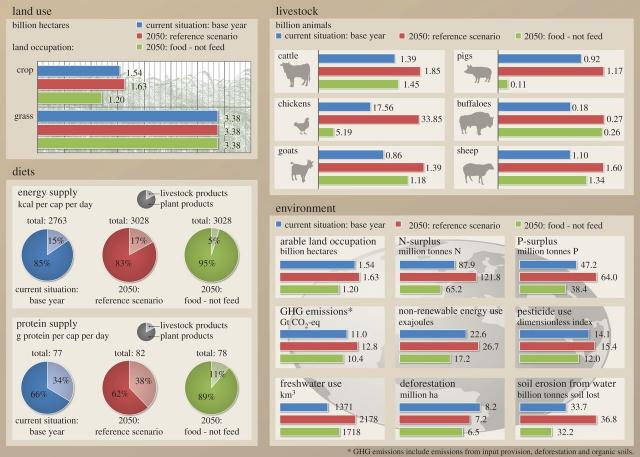Impacts of feeding less food-competing feedstuffs to livestock on global food system sustainability
Christian Schader, Research Institute of Organic Agriculture (FiBL), Switzerland, christian.schader@fibl.org
A recent study (Schader et al., 2015) analysed the impacts of reducing food-competing feedstuffs, i.e. feedstuffs that grow on arable land which could also be used for direct food production, on food availability, diet composition and a number of environmental impacts. It concludes that reducing the proportion of animal feed grown on arable land would have a positive effect on the availability of food and important environmental indicators such as reduction in greenhouse gas (GHG) emissions by 18% and in nitrogen surplus by 46%. Less competition between production of food and animal feed proves to be an effective approach to sustainably providing food for the estimated 10 billion people in 2050. This strategy would clearly have implications on human diets, as the availability of meat, milk and eggs would be lower than the projected demand for 2050. The global availability of livestock products per person would have to decrease by 53%, compared to today’s consumption levels. Especially the availability of meat from pig and poultry (-91%) as well as eggs (-90%) would be affected substantially (Figure 1).

Figure 1: Impacts of feeding less food-competing feedstuffs to livestock (‘food - not feed’) on land use, livestock numbers, human diets and the environment in 2050.
The relationship between meat consumption and environmental damage of agriculture has long been a controversial topic. A common conclusion is to further intensify animal husbandry, i.e. to produce more high-energy concentrate feed on arable land. It is often regarded as the only way to meet the increasing demand for animal-based food and to reduce GHG per kg meat. However, this study shows that reducing concentrate feed produced on arable land has great potential for realising sustainable food systems. Furthermore, the strategy ideally complements already existing approaches for enhancing food security like improving the efficiency of food production, distribution and use as well as decreasing consumption.
A global model system was designed in order to calculate various scenarios of food availability and impacts of food production on the environment. This model system is able to calculate the complex material flows and resulting production volumes and environmental impacts of our food systems. This allows for an in-depth analysis of changes in production methods and food consumption. The system is consistent with global statistics of the FAO and can be used in the future to answer various questions on the sustainability of agricultural and food systems.
Further reading:
Schader, C., A. Müller, N. El-Hage Scialabba, J. Hecht, A. Isensee, K.-H. Erb, P. Smith, H. P. S. Makkar, P. Klocke, F. Leiber, P., Schwegler, M., Stolze and U. Niggli (2015). 'Impacts of feeding less food-competing feedstuffs to livestock on global food system sustainability'. Journal of the Royal Society Interface 12: 0891, pp. 1-12.

